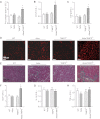Loss of TIMP3 selectively exacerbates diabetic nephropathy
- PMID: 22896043
- PMCID: PMC3518187
- DOI: 10.1152/ajprenal.00349.2012
Loss of TIMP3 selectively exacerbates diabetic nephropathy
Abstract
Diabetic nephropathy is the most common cause of end-stage renal disease. Polymorphism in the tissue inhibitor of metalloproteinase-3 (TIMP3) gene, and the ECM-bound inhibitor of matrix metalloproteinases (MMPs), has been linked to diabetic nephropathy in humans. To elucidate the mechanism, we generated double mutant mice in which the TIMP3 gene was deleted in the genetic diabetic Akita mouse background. The aggravation of diabetic injury occurred in the absence of worsening of hypertension or hyperglycemia. In fact, myocardial TIMP3 levels were not affected in Akita hearts, and cardiac diastolic and systolic function remained unchanged in the double mutant mice. However, TIMP3 levels increased in Akita kidneys and deletion of TIMP3 exacerbated the diabetic renal injury in the Akita mouse, characterized by increased albuminuria, mesangial matrix expansion, and kidney hypertrophy. The progression of diabetic renal injury was accompanied by the upregulation of fibrotic and inflammatory markers, increased production of reactive oxygen species and NADPH oxidase activity, and elevated activity of TNF-α-converting enzyme (TACE) in the TIMP3(-/-)/Akita kidneys. Moreover, while the elevated phospho-Akt (S473 and T308) and phospho-ERK1/2 in the Akita mice was not detected in the TIMP3(-/-)/Akita kidneys, PKCβ1 (but not PKCα) was markedly elevated in the double mutant kidneys. Our data provide definitive evidence for a critical and selective role of TIMP3 in diabetic renal injury consistent with gene expression findings from human diabetic kidneys.
Figures








References
-
- Amour A, Slocombe PM, Webster A, Butler M, Knight CG, Smith BJ, Stephens PE, Shelley C, Hutton M, Knauper V, Docherty AJ, Murphy G. TNF-alpha converting enzyme (TACE) is inhibited by TIMP-3. FEBS Lett 435: 39–44, 1998 - PubMed
-
- Awad AE, Kandalam V, Chakrabarti S, Wang X, Penninger JM, Davidge ST, Oudit GY, Kassiri Z. Tumor necrosis factor induces matrix metalloproteinases in cardiomyocytes and cardiofibroblasts differentially via superoxide production in a PI3K γ-dependent manner. Am J Physiol Cell Physiol 298: C679–C692, 2010 - PubMed
-
- Babu D, Soenen SJ, Raemdonck K, Leclercq G, De Backer O, Motterlini R, Lefebvre RA. TNF-alpha/cycloheximide-induced oxidative stress and apoptosis in murine intestinal epithelial MODE-K cells. Curr Pharm Des. [Epub ahead of print] - PubMed
-
- Basu R, Oudit GY, Wang X, Zhang L, Ussher JR, Lopaschuk GD, Kassiri Z. Type 1 diabetic cardiomyopathy in the Akita (Ins2WT/C96Y) mouse model is characterized by lipotoxicity and diastolic dysfunction with preserved systolic function. Am J Physiol Heart Circ Physiol 297: H2096–H2108, 2009 - PubMed
Publication types
MeSH terms
Substances
Grants and funding
LinkOut - more resources
Full Text Sources
Medical
Molecular Biology Databases
Miscellaneous

